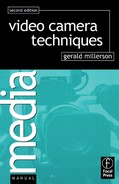Generally found in larger production centers, the studio or production camera is a state-of-the-art piece of equipment, producing pictures of the highest broadcast quality. It is normally linked with others in a multi-camera setup – for newscasts, panel shows, interviews, drama, comedy shows, etc. When used outside the studio (e.g. at public events), it is usually set up at fixed viewpoints overlooking the action.
There are important differences between this type of camera and those we met earlier. It is not self-contained. It forms part of a centralized system.
Each camera is cabled to an associated camera control unit (CCU) outside the studio. (In digital systems, called a base station.) This cable carries all supplies, video, synchronizing pulses, intercom, etc., to and from the camera. The camera’s video signals are processed at the CCU, and adjusted there or at an extension vision control desk, by a specialist operator (shader, vision operator) who continually assesses each camera’s performance (artistically and technically). Where necessary, controls adjust exposure, gamma, picture black level (sit), color balance. This ensures that intercut cameras’ shots are consistent, and matched in color and tonal fidelity.
The cameras’ outputs are then routed to a production switcher for selection by the director, and subsequently passed on to a VTR channel. Sound pickup follows a quite separate route from studio microphone to the VTR soundtrack, via an audio mixer or control console.
The studio camera is fitted with a large zoom lens system, which is adjusted electronically by servo controls on the panning handles (pan bars). Typically, the focus control is attached to the left one, and the zoom control to the right handle. Exposure is controlled at the CCU or vision control desk.
The range of angles covered by the studio zoom lens is designed to suit subject distances within the studio. Field zoom lenses used on remotes (on location) generally have much narrower lens angles; otherwise very distant subjects would appear too small in the shot.
The viewfinder on studio cameras is an open-screen 5 in. or 7 in. type. Wearing earphones or a headset, the camera operator can hear the director’s intercom (talkback) in one ear, while listening to the program sound in the other. Intercom circuits can be communal or switched private wires to individuals (e.g. to the shader/vision operator; lighting director).
The camera head
1. Lens hood (sun shade, ray shade).
2. Zoom lens.
3. Filter wheel.
4. Prism block (beam splitter) with CCD image sensors
5. Camera cable.
6. Adjustable panning handle (pan handle, pan bar).
7. Twist-grip zoom control.
8. Focus control (many cameras use a control mounted on a panning handle – RHS).
9. Shot box (mounted on the camera head, or on a panning handle – RHS).
10. Monochrome viewfinder (perhaps with magnifying lens).
11. Viewfinder controls (including hi-peaker, crispening image detail).
12. Indicators: mimic tally light, lens-aperture indicator (f-stop), zoom lens setting (focal length/lens angle), etc.
13. Camera card clip.
14. Headset jack points (intercom and program) with volume controls. Mixed viewfinder feeds switch.
15. Zoom lens range-extender switch.
16. Call button (contacts shader/video control).
17. Camera mounting head (panning head/pan head), with drag adjustment for tilt and pan action, and tilt/pan locks. Also tilt fore-aft balance adjustment.
18. Tally light with camera number, illuminated when camera selected to line on switcher.

